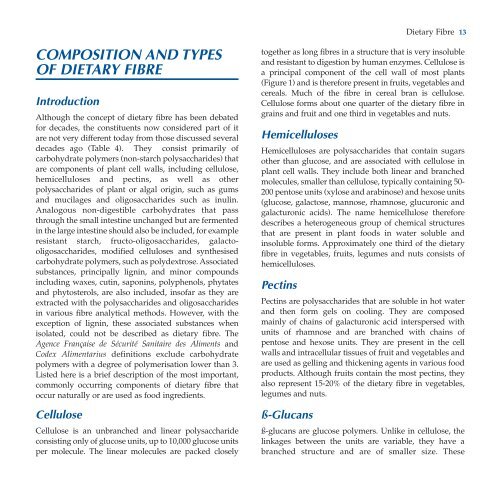Dietary Fibre - ILSI Argentina
Dietary Fibre - ILSI Argentina
Dietary Fibre - ILSI Argentina
Create successful ePaper yourself
Turn your PDF publications into a flip-book with our unique Google optimized e-Paper software.
<strong>Dietary</strong> <strong>Fibre</strong> 13<br />
COMPOSITION AND TYPES<br />
OF DIETARY FIBRE<br />
Introduction<br />
Although the concept of dietary fibre has been debated<br />
for decades, the constituents now considered part of it<br />
are not very different today from those discussed several<br />
decades ago (Table 4). They consist primarily of<br />
carbohydrate polymers (non-starch polysaccharides) that<br />
are components of plant cell walls, including cellulose,<br />
hemicelluloses and pectins, as well as other<br />
polysaccharides of plant or algal origin, such as gums<br />
and mucilages and oligosaccharides such as inulin.<br />
Analogous non-digestible carbohydrates that pass<br />
through the small intestine unchanged but are fermented<br />
in the large intestine should also be included, for example<br />
resistant starch, fructo-oligosaccharides, galactooligosaccharides,<br />
modified celluloses and synthesised<br />
carbohydrate polymers, such as polydextrose. Associated<br />
substances, principally lignin, and minor compounds<br />
including waxes, cutin, saponins, polyphenols, phytates<br />
and phytosterols, are also included, insofar as they are<br />
extracted with the polysaccharides and oligosaccharides<br />
in various fibre analytical methods. However, with the<br />
exception of lignin, these associated substances when<br />
isolated, could not be described as dietary fibre. The<br />
Agence Française de Sécurité Sanitaire des Aliments and<br />
Codex Alimentarius definitions exclude carbohydrate<br />
polymers with a degree of polymerisation lower than 3.<br />
Listed here is a brief description of the most important,<br />
commonly occurring components of dietary fibre that<br />
occur naturally or are used as food ingredients.<br />
Cellulose<br />
Cellulose is an unbranched and linear polysaccharide<br />
consisting only of glucose units, up to 10,000 glucose units<br />
per molecule. The linear molecules are packed closely<br />
together as long fibres in a structure that is very insoluble<br />
and resistant to digestion by human enzymes. Cellulose is<br />
a principal component of the cell wall of most plants<br />
(Figure 1) and is therefore present in fruits, vegetables and<br />
cereals. Much of the fibre in cereal bran is cellulose.<br />
Cellulose forms about one quarter of the dietary fibre in<br />
grains and fruit and one third in vegetables and nuts.<br />
Hemicelluloses<br />
Hemicelluloses are polysaccharides that contain sugars<br />
other than glucose, and are associated with cellulose in<br />
plant cell walls. They include both linear and branched<br />
molecules, smaller than cellulose, typically containing 50-<br />
200 pentose units (xylose and arabinose) and hexose units<br />
(glucose, galactose, mannose, rhamnose, glucuronic and<br />
galacturonic acids). The name hemicellulose therefore<br />
describes a heterogeneous group of chemical structures<br />
that are present in plant foods in water soluble and<br />
insoluble forms. Approximately one third of the dietary<br />
fibre in vegetables, fruits, legumes and nuts consists of<br />
hemicelluloses.<br />
Pectins<br />
Pectins are polysaccharides that are soluble in hot water<br />
and then form gels on cooling. They are composed<br />
mainly of chains of galacturonic acid interspersed with<br />
units of rhamnose and are branched with chains of<br />
pentose and hexose units. They are present in the cell<br />
walls and intracellular tissues of fruit and vegetables and<br />
are used as gelling and thickening agents in various food<br />
products. Although fruits contain the most pectins, they<br />
also represent 15-20% of the dietary fibre in vegetables,<br />
legumes and nuts.<br />
ß-Glucans<br />
ß-glucans are glucose polymers. Unlike in cellulose, the<br />
linkages between the units are variable, they have a<br />
branched structure and are of smaller size. These

















